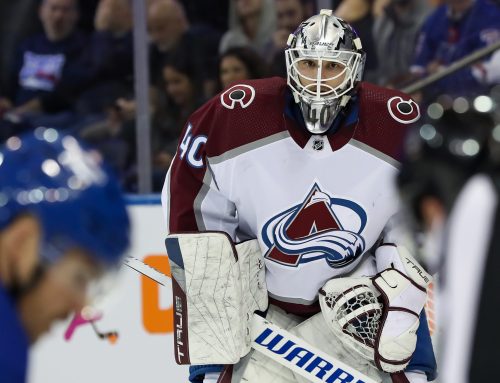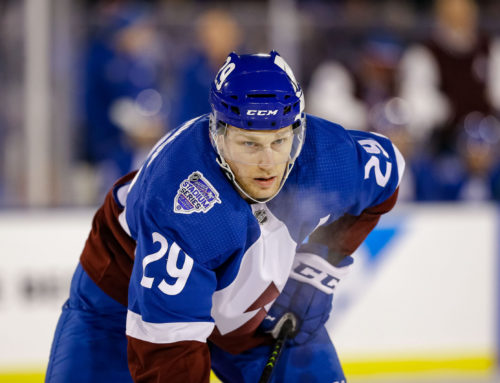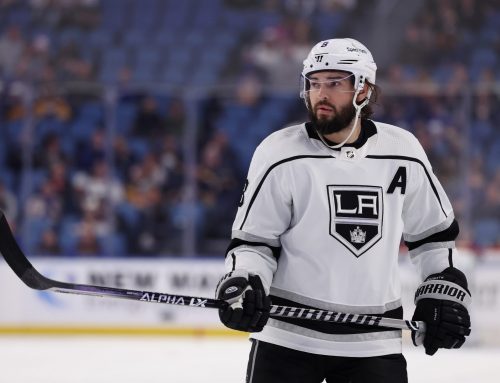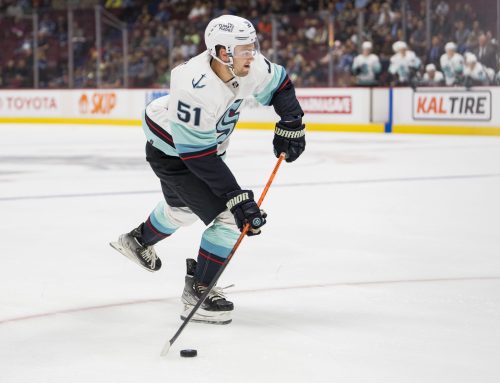Do You Believe in Magic? (West 2011)
Ryan Ma
2011-08-16

If you are an avid reader of the DobberHockey website you probably are familiar with the popular mantra the "magical fourth year". There has been plenty of debate on whether or not this concept truly exists with plenty of arguments for and against. I've spent quite a few hours compiling all of the numbers and doing research in an attempt to finally settle (?) the debate.
All of the research can be found in the attached Excel file. Feel free to download it and browse at your leisurely pleasure.
Basically, what I did was track the career progression of 212 NHL players from season to season looking at their overall seasonal point totals as well as their point-per-game totals. The following tables are a summation of the information that I found.
|
Year |
Overall Average Point Production of all 212 players |
Percentage Increase Compared to Previous Year |
|
1 |
31.1 |
– |
|
2 |
42.2 |
35.7 |
|
3 |
45.9 |
8.8 |
|
4 |
52.9 |
15.3 |
|
5 |
56.0 |
5.9 |
|
6 |
55.3 |
4.5 |
|
7 |
55.2 |
-0.2 |
|
8 |
59.8 |
8.3 |
|
9 |
59.1 |
-1.2 |
|
10 |
59.2 |
0.1 |
|
11 |
55.2 |
-7.8 |
|
12 |
53.6 |
-3.9 |
|
13 |
52.5 |
-3.1 |
|
14 |
50.4 |
-4.0 |
|
15 |
48.3 |
-4.2 |
Looking at the table, it's not surprising to see a big jump between the rookie season and the sophomore season (which kind of debunks the sophomore slump myth doesn't it?). Most rookies tend to get eased into the NHL, with a checking type role in their first year to help get acclimatized with the 'Bigs' and then begin to gain a bit more rope/responsibility during their second season. So, the large jump of over 35 percent can be reasonably justified. The second interesting point to note is the jump between third and fourth seasons. Most of the increases/decreases from season to season are below the 10 percent mark, but between the third and fourth seasons there's a much larger variation of 15.3 percent from the previous season. Is this enough justification to support the theory of the "magical fourth year"? Last point to note is that it's on average a player begins to hit their prime around year 5 and begins to decline around year 10.
Obviously with injuries playing a major role in affecting point production, I decided to take it one step further and look at average point-per-game totals of the 212 NHL players and here are the results:
|
Year |
Overall Average Point-Per-Game Production of all 212 players |
Increase Compared to Previous Year |
|
1 |
0.48 |
– |
|
2 |
0.58 |
0.10 |
|
3 |
0.64 |
0.06 |
|
4 |
0.71 |
0.07 |
|
5 |
0.77 |
0.06 |
|
6 |
0.78 |
0.01 |
|
7 |
0.78 |
0 |
|
8 |
0.83 |
0.05 |
|
9 |
0.80 |
-0.03 |
|
10 |
0.80 |
0 |
|
11 |
0.78 |
-0.02 |
|
12 |
0.77 |
-0.01 |
|
13 |
0.74 |
-0.03 |
|
14 |
0.69 |
-0.05 |
|
15 |
0.66 |
-0.03 |
Much like the overall point production graph above, the point-per-game graph and table illustrate a very similar trend. It also shows a big jump in production between rookie and sophomore years as well as a decent jump in production between the third and fourth years. What's interesting is that the point-per-game percentage increase between the second and third years isn't that far off from the third and fourth years as it was with the overall point production table. On average a player only increases his point totals by 3.7 points between second and third years compared to 7.0 between third and fourth years. Food for thought? The decline in point-per-game numbers seems to hold off a little bit longer than in the overall point production graph. Players tend to last till the 13th NHL season before experiencing a significant drop off in point-per-game production.
Here's a list of the top-15 most productive fourth-year players in recent history
|
Name |
1st |
2nd |
3rd |
4th |
|
Mark Recchi |
67 |
113 |
97 |
123 |
|
Dany Heatley |
67 |
89 |
25 |
103 |
|
Ilya Kovalchuk |
51 |
67 |
87 |
98 |
|
Patrick Elias |
35 |
50 |
72 |
96 |
|
Zach Parise |
32 |
62 |
65 |
94 |
|
Mike Modano |
75 |
64 |
77 |
93 |
|
Ryan Getzlaf |
39 |
58 |
82 |
91 |
|
Brian Gionta |
11 |
25 |
29 |
89 |
|
Pavel Datsyuk |
35 |
51 |
68 |
87 |
|
Andy McDonald |
28 |
21 |
30 |
85 |
|
Jeff Carter |
42 |
37 |
53 |
84 |
|
Derek Roy |
19 |
46 |
63 |
81 |
|
Anze Kopitar |
61 |
77 |
66 |
81 |
|
Mike Cammalleri |
8 |
15 |
55 |
80 |
|
Mike Richards |
34 |
32 |
75 |
80 |
A lot of the names above are recognizable, house-hold names. They can certainly provide a solid case to help prove the existence of a "magical fourth year". With that said, the fourth year is not the lone year where players saw a "breakout" year. Dobber himself even said as much in the Fantasy Guide. Here's a list of players who've experienced a breakout in other years.
Third Year Breakouts
|
Name |
1st |
2nd |
3rd |
|
Evgeni Malkin |
85 |
106 |
113 |
|
Alex Ovechkin |
106 |
92 |
112 |
|
Nicklas Backstrom |
69
📢 advertisement:
|
88 |
101 |
|
Patrick Kane |
72 |
70 |
88 |
|
Henrik Zetterberg |
44 |
43 |
85 |
|
Jason Pominville |
30 |
68 |
80 |
Fifth Year Breakouts
|
Name |
1st |
2nd |
3rd |
4th |
5th |
|
Milan Hejduk |
48 |
72 |
79 |
44 |
98 |
|
Martin St. Louis |
18 |
40 |
35 |
70 |
94 |
|
Alex Semin |
22 |
73 |
42 |
79 |
84 |
|
Marian Hossa |
30 |
56 |
75 |
66 |
80 |
Sixth Year Breakouts
|
Name |
1st |
2nd |
3rd |
4th |
5th |
6th |
|
Joe Thornton |
7 |
41 |
60 |
71 |
68 |
101 |
|
Corey Perry |
25 |
44 |
54 |
72 |
76 |
98 |
|
Jarome Iginla |
50 |
32 |
51 |
63 |
71 |
96 |
|
Daniel Sedin |
34 |
32 |
31 |
54 |
71 |
84 |
|
Scott Gomez |
70 |
63 |
48 |
55 |
70 |
84 |
|
Mike Ribeiro |
18 |
17 |
65 |
51 |
59 |
83 |
|
Henrik Sedin |
29 |
36 |
39 |
42 |
75 |
81 |
An interesting point to note is that players that breakout during their fourth, fifth and sixth seasons tend to be of the "older generation" (pre-lockout). The "newer generation" (post-lockout), of youngsters tend to have a bit of an accelerated curve where they're starting to gain a larger role of responsibility at an earlier age, which might be something that you'd want to keep in mind for Matt Duchene, John Tavares and James Van Riemsdyk.
The point that I'm trying to make is that the "magical fourth year" isn't a one size fits all model. As you can see from the tables above, there are plenty of players who don't experience a "magical fourth year", but with that said, the fourth year is, statistically speaking, the year where players experience the largest point increase compared to their previous year's production. It is entirely up to you whether you are a believer of the "magical fourth year" or not. All I can do is to present my case.
Below is the list of players who are entering their fourth NHL season this year, along with my opinion and projection as to whether they are going to be poised to have a huge breakout year or are they going to be a blip on the radar.
Note: I used 20 games played as a cut off to count as a season played. If a player played 19 games their "rookie" season, I counted the next season as their true rookie year.
Poised for a huge breakout year (80+ or point-per-game)
Peter Mueller – There's only one candidate out west that I feel could be in for a huge breakout season and that's Mueller. He sat out the entire year last season dealing with a serious concussion issue, but it all seems behind him now. The latest news coming out of Colorado is that he has resumed skating and is raring to go for training camp. The last time he suited up for the Avs. He picked up 20 points in 15 contests, 18 of which came when playing alongside Matt Duchene and Milan Hedjuk. Both of the players still remain in Colorado, so it'll be interesting to see if they still have some residual chemistry left for 2011-12. I wouldn't be surprised to see an 80-point Mike Cammalleri-like season from Mueller this campaign.
Poised for a marginal breakout year (50-65 points)
Michael Frolik – Frolik's NHL career has been a bit of a rollercoaster ride so far. He began in a very turbulent Florida franchise then was subsequently traded to the Hawks where he spent the majority of his time toiling in a third-line checking role. With the departures of Troy Brouwer and Tomas Kopecky, Frolik should enjoy a bit of time in the Hawks' top-six, hopefully resulting in him surpassing his career-high of 45 points. One of the big positives for Frolik is that he isn't afraid to shoot the puck (career 2.61 SOG per game average). Generally speaking players that tend to shoot the puck tend to have high point totals than those that don't. I'd look for something around the 50-55 point mark, but if there is a major injury to Patrick Kane or Marian Hossa, Frolik's fantasy value could skyrocket.
T.J. Oshie – All of the Blues' offensive players are in a bit of a unique situation this campaign. Many could argue that they have one of the best youngest players with offensive upside in the league. The question that I posed in last week's column was whether or not there is going to be enough offense to spread around amongst them. St. Louis boasts a top-10 in which each and every player has had a 40-point season within the last two years. Offensive depth is not going to be a problem, which is why it's going to be a crapshoot as to making projections for Blues' this campaign, especially when there's four of them heading into their "magical fourth year". After all of the dust settled post-trade deadline, three players managed to escape un-phased. One of which was Oshie, who still managed to garner 19:02, 2:01 of which was on the PP, 2.56 SOG and 0.61 points per game respectively. As I mentioned previously, it's going to be a complete crapshoot to project for the Blues, but for me, I just have inkling that Oshie might be the front runner on the offense-by-committee team.
Derek Brassard – I slotted Brassard in last season's column, but after readjusting my criteria, I really shouldn't have counted his 17-game rookie season, which then makes this season his "real" magical fourth year. During his first three years, he's shown steady progression from 25 to 36 and then last year's total of 47 points. If you follow it linearly, the logical pattern of the next number falls on 58, which would certainly be a nice total to have as a sneaky late round pick up. With newly acquired Jeff Carter there, many would think that Brassard would fail to garner enough ice-time in order to put up 58 points. My argument would be that Brassard and Rick Nash's styles of play seem to complement each other (56% of Nash's points last season occurred when Brassard was on the ice), much more than Carter and Nash, who are both shoot-first types of players. If they played on the same line I could certainly see an Olli Jokinen-Jarome Iginla type situation where the chemistry is just not there and it ends up detracting from the offense rather than helping it. Don't dive head first into Brassard's stock, but definitely take note of his name as a possible late-round steal come draft time.
Patric Hornqvist – It seems as though Hornqvist has been around for ages, but I was quite shocked to find the former seventh-round draft pick is only heading into his "magical fourth season" this campaign. He's already posted consecutive 48+ point seasons and certainly is in line for a third. During the last 11 games of the season, the trio of Mike Fisher, Sergei Kostitsyn and Hornqvist combined for a whopping 29 points in which Hornqvist averaged 1.27 points-per-game during that span. The only drawback is that he does play for the Preds, which has produced only three 60+ point producers since 2007. But if that trio can reignite some of that chemistry, there could be a very under-rated line that would surprise many coming out of Nashville.
Cal Clutterbuck – I was a bit torn as to where to slot Clutterbuck, but I decided to give him the benefit of the doubt mainly because of the lack of depth in Minnesota this year. If you're read my Earmarked for Success series, then you'll probably realize that the top-five spots in Minny are pretty much locked, with the sixth going to be battled out between the oft-injured Guillaume Latendresse, Kyle Brodziak and Clutterbuck. If you're a fairly knowledgeable poolie, then you'll probably realize that it won't be the point totals that will be the main reason why you'll own Clutterbuck. It's going to be the league-leading 336 HITs that are going to be the primary reason for owning him. The points attached become a secondary matter. If you're after just the points then drop him a few notches and expect a ceiling of 40, but nothing more.
Sitting on the Fence (<50)
Patrik Berglund – I know there's going to be many of you from the Berglund camp that'll jump all over me on this one, but similarly to the Oshie situation, there's just an inkling inside of me that thinks Berglund will be a big fantasy flop this season. Talent, offensive upside and skating ability aren't the major problems for me, it's the depth chart, and that's much more of an obstacle to a player's production than all of the factors listed above. Following the trade deadline, Berglund ranked behind Andy McDonald, David Backes, Oshie, and Chris Stewart in terms of overall time on ice. Now if you factor in Jason Arnott and Jamie Langenbrunner into the mix, I just don't know if Berglund is going to garner enough ice-time to put up fantastic numbers to wow us poolies. Obviously, situations can change, but I'd head into the season a bit leery. I know it's a bit low, but expect 45-50 and you should be okay.
Matt D'Agostini – Pretty much ditto as above, minus the talent and offensive upside. D'Agostini had a great run at the end of the season where he notched 18 points in the final 20 contests, but that might have been due solely to playing alongside McDonald and Backes who had great chemistry with each other. If, and a very big one, they get reunited and rekindle some of that chemistry then D'Agostini's value might increase, but if he gets relegated to third-line checking duties, then he probably maintains little to no fantasy value. Big boom or bust candidate for 2011-12.
Chris Stewart – The last of the "magical fourth year" candidates for the Blues. Stewart also had a great finale with the Blues as he notched 23 points in 26 contests following the trade from Colorado to St. Louis. He definitely demonstrated plenty of chemistry with Berglund and formed quite a formidable duo. The question as I posed earlier is whether or not it can be sustained throughout the year? Look at the following table for the answer:
|
Name |
Point-per-game average post-trade deadline |
Pro-rated (82 games) |
|
McDonald |
0.95 |
77 |
|
D'Agostini |
0.90 |
73 |
|
Backes |
0.80 |
65 |
|
Stewart |
0.80 |
65 |
|
Berglund |
0.58 |
47 |
|
Oshie |
0.61 |
50 |
|
Steen |
0.50 |
41 |
Now keep in mind you also have to include Arnott, Langenbrunner and possibly Perron into the mix as well. In my humble opinion, I just don't think that it can be sustained. Expect something similar to Berglund (45-50) and you should be okay, while anything more and you could set yourself up for disappointment.
Lauri Korpikoski – Korpikoski is in a bit of an interesting scenario. He doesn't possess the same offensive upsides as a lot of the other "magical fourth year" candidates, but is in a great situation where the depth chart is completely in his favour. I highlighted the fact that the Yotes lost two major pieces (Vern Fiddler and Eric Belanger) in terms of puck possession through faceoff wins during Dobber's ramblings last week, and a player that they'll utilize to try to fill the void will be Korpikoski. Behind the aforementioned duo plus Martin Hanzal and Kyle Turris, Korpikoski ranked fifth in terms of face off attempts for Phoenix. He wasn't very good, winning just 43 percent of his opportunities, but should see an improvement on his 15:31 TOI/game average just based solely on the fact that they'll need someone to take faceoffs after Hanzal and Turris. Points-wise look for 35-40 but not a lot more as his offensive upside just isn't there.
James Sheppard – If there was a player that was in desperate need of a change of scenery then it has to have been Sheppard. Since 2004, the Wild haven't really had great success in translating prospects into NHL talent, which is why the recent trade to the Sharks might be the career boost that Sheppard needed to salvage his NHL career. If you compare the Wild with the Shark prospects, there's almost a night and day difference between the two clubs.
|
Wild |
Sharks |
|
A.J. Thelen |
Lukas Kaspar |
|
Benoit Pouliot |
Devin Setoguchi |
|
James Sheppard |
Ty Wishart |
|
Colton Gillies |
Logan Couture |
|
Tyker Cuma |
Nick Petrecki |
|
Nick Leddy |
|
If you read my column last week, you probably read that generally speaking the Sharks do a very good job of developing young talent. Sheppard certainly has the pedigree to become a very solid NHL producer, and the Sharks organization might just be the best environment for him to flourish in. Martin Havlat and Ryane Clowe aren't exactly the ironmen of the NHL, so Sheppard should receive some opportunity in the Sharks' top-six throughout the season. Look for 30-35 points as he attempts to re-establish his NHL career.
Other Notables
Andrew Ebbett, Mikkel Boedker, B.J. Crombeen, Jannik Hansen, Kevin Porter, Jamie McGinn, Derek Dorsett, Cal O'Reilly, and Brad Staubitz
Defense
Most of us have heard of the phrase "It takes defenseman longer to develop in the NHL than forwards." Last season I took a look at a small sample of d-men and there wasn't a lot of empirical evidence to back the theory of the "magical fourth year" for blue liners. Of course that shouldn't prevent you from ignoring them completely, so here are a few Western Conference D-men who are entering their fourth year this season.
Drew Doughty – Doughty and his management team are still butting heads with the Kings' organization for his next contract, but things should be completed before the season starts. DD had a bit of a down year last year compared to his sophomore breakout campaign where he notched 59 points. That year he faced little competition from Jack Johnson, which resulted in DD completely controlling his fate. Now that JJ is rounding into form, expect much of the same as last season where the production will most likely be split evenly between the two.
Niklas Hjalmarsson – The Hawks defensive corps last season could easily have been broken down to a big three of Duncan Keith, Brent Seabrook and Brian Campbell, then the fill-ins of Hjalmarsson, Chris Campoli, Nick Leddy and Jason Cullimore. This season Chicago will have a bit of a different look, as Hjalmarsson should see a much larger role with the departure of Campbell and Campoli. Steve Montador and Sami Lepisto might threaten a bit of the PP time, but Hjalmarsson should get first crack on the second unit. Look for a rebound back towards the 25-30 point mark to help fill the offensive void left by Campbell.
Erik Johnson – There probably isn't a defenseman with a larger chip on his shoulder heading into this campaign than EJ, except the possibility of Sheldon Souray?). He was a highly-touted defensive prospect in which the Blues utilized their first overall pick back in 2006 to acquire Johnson. The Blues were unhappy with his development and subsequently moved him to the Avs for Stewart and their first round pick this summer. He didn't exactly have a huge breakout after the move when he registered just 10 points in 22 contests with his new club, but with the number one PP QB gig handed to him on a silver platter, Johnson should have a very good fourth campaign. I'm going to go out on a limb and project that he tallies upwards of 40 points this season.
Kyle Quincey – Quincey might be a player that's going to be largely forgotten heading into this season because of his production from last campaign. He registered just one lone point in 21 contests, and was sidelined for the remainder of the season with a shoulder injury. The Avs have been pretty quiet about the news, as I can't even dig up what kind of injury he sustained. My guess is that it's a torn labrum. What you have to keep in mind with Quincey is that he did post a 38 and 29 point seasons prior to last year, so the offensive upside is certainly there. EJ and Jan Hejda should be the top pairing, leaving Quincey and possibly Stefan Elliott as the possible number two pairing. Both players have an offensive edge to their game and could produce some surprising numbers. Don't forget Quincey's name during the late rounds of your drafts.
Check back Thursday for the second half of this article which will discuss the fourth year players from the Eastern Conference. It's going to be a doozy! Questions or comments? Post in the section below and I'll be more than happy to discuss.





 CAR
CAR NYI
NYI BOS
BOS TOR
TOR VAN
VAN MTL
MTL EDM
EDM WPG
WPG
